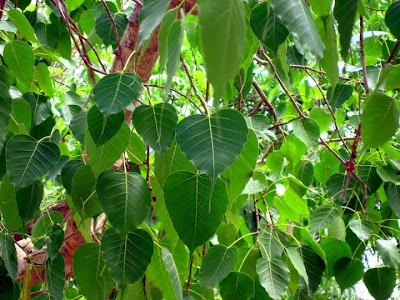Guavas (Psidium guajava) are tropical fruits of Myrtaceae family, cultivated and enjoyed in many tropical and subtropical regions. It is low evergreen tree or shrub which is usually 6 to 25 feet high with wide spreading branches and downy twigs. The leaves are usually 3-6 inches long, oblong or oval and blunt in shape. The Fruits are Green in color and When ripen turns to yellow. Packed with a myriad of hard, tiny seeds at the centre, guavas have a distinct flavour and lovely aroma.
These fruits are also known for their high-profile nutrients and multiple health benefits. It is consumed raw or in the form of jams and jellies. Guava is low in calories and fats but contains several vital vitamins, minerals, and antioxidant compounds that play a pivotal role in preventing and curing various health problems.
 |
| Guava (Psidium guajava) |
- Guavas are extremely good sources of vitamin A, known to prevent degradation of vision, slow down the appearance of cataracts, macular degeneration, and improve eye sight.
- Owing to its high fibre content and low glycemic content, guavas helps to regulate the absorption of sugar, which decreases the chances of major spikes and drops in insulin and glucose in the body. Studies have shown that consuming guava can help prevent the appearance of diabetes.
- Guavas being one of the richest sources of vitamin C, provide the immune system a huge boost in antioxidants and protect against common infections and pathogens. This fruit is a very good source of vitamin A and flavonoids like beta-carotene, lycopene, lutein and cryptoxanthin. The compounds are known to have antioxidant properties and therefore essential for optimum health.
- Antioxidants are the major lines of defense against the proliferation of free radicals in the body, which are one of the main causes of serious conditions like cancer. Clinical studies have shown that the potent antioxidants present in guava tend to reduce the risk of prostate cancer, breast cancer and oral cancer by preventing the growth of metastatic cells. Guavas are also rich in lycopene, a powerful antioxidant that has been shown to be successful in reducing risk of prostate cancer. Lycopene has also shown to inhibit the growth of breast cancer cells, although further human trials need to be done.

Guava Tree - Guavas are a rich source of vitamin C and iron, which are known to prevent against cold and viral infections. The juice of the fruit or a decoction of guava leaves is helpful in relieving cough and cold since it helps to get rid of mucus and disinfects the respiratory tract, throat and lungs. (Note: one should avoid drinking water immediately after eating guava as it can lead to a sore throat).
- Guava is one of the richest sources of dietary fibre. Consuming one guava fulfils about 12% of our daily recommended intake of fibre, which makes it extremely beneficial for healthy bowel movement and overall digestive health.
- Fresh guavas are a rich source of potassium, an important component of cell and body fluids that controls heart rate and hypertension. These fruits, being rich in fiber and hypoglycemic in nature, help reduce blood pressure. Further this also helps reduce cholesterol in the blood and prevents it from thickening, thereby maintaining the fluidity of blood. Guavas help lower the levels of triglycerides and bad cholesterol (LDL), which lead to the development of heart diseases.
- Owing to their anti-inflammatory action and antibacterial ability, guava leaves have been known to cure toothache, swollen gums and oral ulcers. Being a good source of vitamin C, consuming guavas also protect against scurvy.
 The magnesium present in guavas is helpful in giving our body system a good energy boost and combat stress. Vitamin B3 (niacin) and B6 (pyridoxine) present in the fruit, help in improving blood circulation to the brain, stimulating cognitive function and relaxing the nerves.
The magnesium present in guavas is helpful in giving our body system a good energy boost and combat stress. Vitamin B3 (niacin) and B6 (pyridoxine) present in the fruit, help in improving blood circulation to the brain, stimulating cognitive function and relaxing the nerves.- The astringent property of the fruit is useful in maintaining a healthy glowing skin! Application of the fruit pulp as a face scrub or a face mask is believed to help cure skin discoloration, wrinkles, premature aging and acne irritation. Also, it helps tone up and tighten the facial muscles! Guavas being high in vitamin A, B, C and K, minerals and antioxidants like carotene and lycopene, are helpful in maintaining skin’s radiance and keep other dermal disorders at bay.
- Guava aids weight loss by regulating the body metabolism. Being high in fiber content, it satisfies the appetite easily. Guava also nourishes the body with its rich supply of vitamins, proteins and minerals, less of carbohydrates and no cholesterol!
Read more at:
- Herbal Beautyholics: http://herbalbeautyholics.blogspot.in/
- The Kitchen Clinic: http://thekitchenclinic.blogspot.com/
- Traditional Home Remedies: http://traditionalhomeremedy.blogspot.com/
- The Slimming Furnace: http://theslimmingfurnace.blogspot.in/
- Foods for Cancer Prevention: http://foodforcancerprevention.blogspot.in/
- HerbHealtH: http://drgarimasancheti.blogspot.com/
- प्राकृतिक उपचार: http://prakritikupchar.blogspot.in/



.jpg)

.jpg)
.jpg)

.jpg)
.jpg)


.jpg)


_leaves_at_Narendrapur_W_IMG_4101.jpg)
.jpg)

